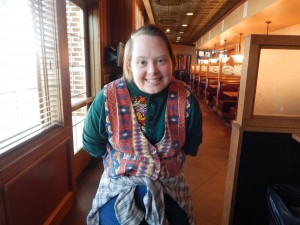Long before opening hours, the Great Dane in Madison is alive, hustling and bustling as workers prepare for the day. No customers, no orders — just the ordinary setup for the day. Chelsea Lucas, Tiffany Turner and Ariel Shafer diligently wash the tables, fill the ice bins, and make the coffee and tea. Silverware is rolled, the condiment caddies are arranged, and menus — famous for resembling newspapers — are placed on tables. The smiles on the faces of the workers never fade.
For these three workers, their jobs at the Great Dane are especially meaningful. While going to work may seem inevitable for most people, for Chelsea, Tiffany and Ariel — people with disabilities — these doors are not always open.

Condiment caddies are placed on tables each morning at the Great Dane at Hilldale in Madison, Wisconsin. Photo by Sophie Dubuisson.
Wisconsin prides itself in being a progressive, charming Midwest state with strong community ties. From towns and cities with populations ranging from less than 1,000 to nearly 600,000, Wisconsin residents are connected through their communities, schools and jobs. Jobs that entail work behind closed doors — the reason for why our table is clean when we’re out to eat or why the ketchup and mustard containers are filled to the top — often go unnoticed and unappreciated. But to Chelsea, Tiffany and Ariel, this work is their opportunity to belong and to be proud. The trio belongs to a minority of people with disabilities who are given the chance to work in their communities, but Wisconsin is working to change this.
“Work is one of the primary ways that all of us are seen as contributors and participants in the community, so ensuring that individuals have access to work in regular community settings is a very high priority,” says Doug Hunt, community program specialist in the Adult Community Services Division of the Dane County Department of Human Services. “We talk a lot about people having valued social roles, a presence in the community, contributing, where you can see their competence, and work has a big part to play.”
Many of Wisconsin’s inclusive and vibrant communities strive to offer all citizens the chance to contribute through paid jobs. For those with disabilities, this employment allows them to live in homes of their own, learn more about diversity and inclusivity and become involved in their communities.
More than 45 years ago, the idea of “supported employment” took off in Wisconsin’s own capital, and Dane County has been leading the way ever since. Lou Brown, a renowned professor in the Department of Rehabilitation Psychology and Special Education at UW-Madison, focuses his research on developing models and values aimed at preparing students with disabilities to integrate into society. Creating equal opportunities and experiences for all citizens is at the heart of Brown’s work.
“We have to make some really major changes in the educational system. And I think they’re coming. I think the pressures are there,” Brown says. “When they finish 21 years of public education, what’s the purpose of it? Well, it’s to prepare people to do real work in a real world. It’s a major part of an educational program. Not the only part, but a major part.”
Spreading this belief, that everybody can work, helped develop formalized funding for employing people with disabilities. Public schools in Dane County began developing paid employment opportunities for students with disabilities, leading to continued support systems for these individuals when they transition to adulthood and want to work in the community.
Chelsea, Tiffany and Ariel clock in at the Great Dane to start their mornings and jump right into making coffee and tea, maybe even some hot chocolate for themselves or their job coach who works alongside them. Their dedication to their work is clear; Chelsea even comes into work on her days off.
“Really? You work on your days off? Why do you come in when you don’t have to work?” I ask. “I like to do it by myself,” Chelsea says with a small grin on her face.

Chelsea Lucas is all smiles while working at the Great Dane at Hilldale in Madison, Wisconsin. Photo by Sophie Dubuisson.
Parents with high expectations for their children’s future have been a strong force in leading Dane County to direct limited public funding into community employment for those with disabilities. The county’s efforts have made it one of the best in the nation for such integrated employment opportunities.
“We’ve chosen to put our dollars and invest our time into trying to help people earn as much as they can, and the best place to do that is in community jobs where they’re going to be paid minimum wage, at least, or above,” Hunt says.
Though Dane County has excelled in employing and integrating those with disabilities into their communities, this isn’t the case across the rest of Wisconsin. If those with disabilities do not have the support system to get them a community job, they will often work for sub-minimum wages in Community Rehabilitation Programs, frequently called “sheltered workshops.”
These facilities are not necessarily detrimental for workers, but they don’t offer the necessary financial support, nor do they allow workers with disabilities to contribute and truly become a part of their home communities. Having a well-paying job in the community creates taxpaying citizens with less reliance on public benefits and services, and, ultimately, less public funding required. This enables their families to continue working as taxpayers, leading to a better quality of life for all involved, according to Monica Bear, community services manager in the adult community services division of the Dane County Department of Human Services.
All in a Day’s Work from UW-Madison SJMC on Vimeo.
Employees like Chelsea and Tiffany work more than one community job, which provides them with the financial income they need to be able to go to the movies, go bowling and enjoy ordinary lives.
Next task at hand — cleaning the tables. Chelsea and Tiffany carefully wipe their half of the tables down while Ariel and his job coach work on the rest. Other Great Dane employees help with the process, vacuuming and sweeping the floors. A warmth encompasses the entire restaurant.
The benefit of employing those with disabilities is not only for the individual and his or her family, but also for the business. There are often misconceptions about the abilities of workers with disabilities, leading businesses to remain reluctant about hiring them. We often forget that someone with a disability has the ability to learn. A 25-year-old who has a disability is not a child, but rather an able adult who should be given the confidence and ability to contribute through work in his or her community, says Janet Estervig, section chief for the Employment Initiatives in the Department of Health Services.
One of the most important parts of creating employment opportunities for those with disabilities is to educate and make potential employers aware of the benefits that result from employing these people.
“The supported employment approach is selling somebody and their skills and what they can do, and the fact that they’re going to get a loyal employee that comes every day to work because they want to be there and they want to be a part of it, it’s really a different thing for some employers, who don’t maybe always have that in their workforce,” says Chris Witt, executive director of Advanced Employment, which provides supported employment services to adults with developmental disabilities.
The investment of public dollars into the employment of individuals in local businesses is a wise investment based on the mutual benefit to both the worker and the employer involved, experts say. According to Hunt, human services and employment agencies consistently hear from employers that hiring these people adds positivity to the workplace environment.
“They’re excited to come to work and help get the restaurant set up for the day, and that positive energy transfers,” Hunt says. “So what we hear from employers, and from what we know from our own experience, is that it adds to the positive nature of the workplace.”
Not only are these employees excited and ready to work, but they’re reliable and committed. Some workers in Dane County have been employed at the same community job for as long as 30 years. This longevity is a testament to the mutual benefits both workers and businesses earn.
“Not only are you bringing on people that are good workers that show up every single day, and that are consistent with their jobs and that have great attitudes — that’s part of it. But there’s the human aspect of it, which is uplifting your staff,” says Ted Peterson, director of operations at the Great Dane.
Employment for those with disabilities is also an initiative pushed by both Gov. Scott Walker and a team at the Wisconsin Department of Health Services. They’re working to make connections between the agencies that fund employment services, or providers, with employers and businesses to open the doors to employment for people with disabilities.
Two years ago, the governor launched the initiative “Better Bottom Line” with three main goals: get more businesses involved, get people with disabilities to believe that they can work and find reliable providers to fund these services. The businesses can use these reliable workers to help diversify their workforces and truly represent the communities to which they’re attached.
One of the main projects that both the governor and the Department of Health Services continues to work on is Project SEARCH, a school-to-work immersion program that allows recent high school graduates with intellectual and developmental disabilities to learn job skills entirely within the workplace and receive hands-on training. The outcomes of this program are exceedingly high, with 87 percent of people getting paid jobs at minimum wage or above by the time they leave the program. Along with this, Walker set aside $800,000 to expand Project SEARCH sites in Wisconsin, an amount that no other state has dedicated.
“It wouldn’t have happened if he didn’t believe in this program so much,” Estervig says.
Estervig explains that Wisconsin is ahead of the game in tracking the state’s success in placing people in community jobs. Wisconsin gathers data on the status of those in the state’s long-term care services system twice per year. This care service, called “Include, Respect, I Self-Direct,” commonly known as IRIS, collects the information about all workers, including how many hours they work and how much they get paid, from care organizations and providers who fund employment services for those with disabilities.
“There’s a lot of work in that process, just a huge amount of work,” Estervig says. “Not only do we need to have providers that can do that work, we need to have a community that’s going to open their doors, and we need to have opportunities where the community and people with disabilities all can interact and connect with each other. And not every community is really open to that. Not every community is ready for that.”
Today, the status of this effort is shifting due to a 2014 legislation that will change how Wisconsin’s current long-term care system will work. The law directed the current long-term care system in Wisconsin to be shifted from managed-care organizations, like Medicaid provided through regions and counties, to for-profit health maintenance organizations (HMOs) known as integrated health agencies.
These new HMOs will now be determining how to allocate and prioritize public funding for these programs, aiming to lower the overall cost of health services. The goal is to make sure that all services provided are completely integrated in local communities by 2019, as well as to focus on open-market business in Wisconsin.
But this reorganization has caused concerns about what will happen to the supported employment and living services that advocates and parents in Wisconsin have worked so hard to establish. It’s unclear how employment for those with disabilities will fit into this new system, but the hope for many advocates for employment for those with disabilities is that the services that have expanded so tremendously will continue to flourish.
With this change to the system in progress, it is still clear that Wisconsin’s longtime efforts to improve integrated community job opportunities for people with disabilities enables them to rely less on public benefits while allowing them to contribute to their local economies and participate in their communities.
“I see that people with disabilities will be much more integrated in their communities over the next five years,” Estervig says. “I see a significant change in that. And I also see communities opening their doors, as well as individual businesses.”
Advocates for those with disabilities will continue to build communities to fit every person’s needs, because at the end of the day, they believe that we all have something to contribute, and everybody deserves the equal chance to do so.
“People with disabilities enrich my life, it opens doors,” Estervig says. “People with a disability, they see life differently.”
The tables are cleaned and coffee is made. Chelsea, Tiffany and Ariel move on to filling the ice bins, placing the menus and condiment caddies on tables, and, lastly, rolling the silverware into napkins. Their hard work pays off when the Great Dane fills up for lunch and dinner throughout the week, with customers eager for delicious food, unaware of the roles that these workers play.
Sources
“Ready, Willing, and Able to Work: Supporting Employers to Hire Workers with Disabilities”
Janet Estervig, section chief for the Employment Initiatives in the Wisconsin Department of Health Services
Dane County, August 2015 Employer Report and Statedata.info, ID/DD Reported Rate of Integrated Employment
Dane County Department of Human Services
Photos by Sophie Dubuisson
